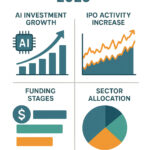Inflation has become one of the most discussed financial topics in the United States in recent years. From grocery store prices to mortgage rates, inflation impacts nearly every aspect of economic life—and its effects on investors can be both significant and unpredictable.
In this blog, we’ll explore:
- The current and historical trends in U.S. inflation
- The key causes of inflation in 2025
- The risks inflation poses to consumers and investors
- Investment strategies to manage inflation risk
- How inflation affects different asset classes
Let’s dive in.
What Is Inflation?
Inflation is the rate at which the general level of prices for goods and services rises, eroding purchasing power over time.
For example, if inflation is 4%, something that costs $100 today will cost $104 a year from now—assuming prices rise uniformly.
U.S. Inflation Trends: A Brief Overview
Historical Inflation Trends
| Decade | Average Annual Inflation |
|---|---|
| 1970s | 7.1% (Oil crisis, wage-price spirals) |
| 1980s | 5.6% (Volcker’s rate hikes tamed inflation) |
| 1990s | 3.0% (Stable, tech-led growth) |
| 2000s | 2.6% (Housing boom and bust) |
| 2010s | 1.8% (Post-Great Recession stagnation) |
| 2020-2023 | Ranged from 1.4% to 9.1% (Pandemic disruptions) |
| 2024 | 3.2% (Moderating but elevated) |
| 2025 (YTD) | 2.7% – 3.5% (Fed targeting 2%) |
Key Takeaway:
After decades of relatively stable inflation, the COVID-19 pandemic, supply chain disruptions, and geopolitical tensions triggered a significant spike—peaking at 9.1% in June 2022.
While inflation has since eased, it’s still above the Fed’s 2% target in 2025.
Causes of Inflation in 2025
Inflation in 2025 is being driven by several key factors:
1. Sticky Services Inflation
- Wages in healthcare, education, and hospitality have risen.
- Service-sector prices are slower to decline than goods.
2. Housing & Rent Increases
- Mortgage rates are high, limiting home sales and keeping rents elevated.
- Shelter costs make up over 30% of the Consumer Price Index (CPI).
3. Energy Price Volatility
- Global instability, including ongoing geopolitical conflicts, continues to influence oil and gas prices.
4. Labor Market Tightness
- Low unemployment keeps upward pressure on wages, fueling demand-driven inflation.
Risk Implications of Inflation
Inflation can create several types of risk for consumers, businesses, and investors:
1. Purchasing Power Risk
- Inflation reduces the value of money over time.
- Savers and retirees are most at risk if their returns don’t outpace inflation.
Example: If your savings earn 2% and inflation is 3.5%, you’re losing money in real terms.
2. Interest Rate Risk
- To control inflation, the Federal Reserve may raise interest rates, which negatively impacts bond prices and borrowing costs.
Higher rates can lead to slower economic growth, reduced corporate profits, and market volatility.
3. Equity Market Risk
- Companies face rising input and wage costs, squeezing profit margins.
- Inflation uncertainty can trigger volatility and reduce investor confidence.
4. Currency Risk
- High inflation can weaken the U.S. dollar relative to other currencies.
- This affects international investments and import/export dynamics.
5. Behavioral Risk
- Inflation may cause investors to chase returns, make hasty portfolio changes, or hold excess cash—often leading to suboptimal results.
How Inflation Affects Different Asset Classes
| Asset Class | Impact of Inflation |
|---|---|
| Stocks | Mixed – some sectors benefit, others suffer from cost pressures |
| Bonds | Typically lose value as rates rise |
| Real Estate | Often a good hedge (rents and property values can rise) |
| Commodities | Tend to perform well during inflation (especially gold, oil) |
| Cash/Savings | Lose purchasing power unless returns exceed inflation |
| TIPS (Treasury Inflation-Protected Securities) | Designed to protect against inflation |
Strategies to Manage Inflation Risk
1. Diversify Your Portfolio
- Spread investments across stocks, bonds, real assets, and commodities.
- Avoid overexposure to sectors vulnerable to inflation (e.g., consumer discretionary during recessions).
2. Invest in Inflation-Protected Assets
- TIPS automatically adjust with inflation.
- Consider real estate investment trusts (REITs) and infrastructure ETFs.
3. Focus on Quality Stocks
- Companies with strong pricing power (e.g., healthcare, utilities, consumer staples) can maintain margins.
- Look for businesses with low debt and high cash flow.
4. Avoid Long-Duration Bonds
- Long-term bonds are more sensitive to rising interest rates.
- Instead, use short-duration bonds, floating-rate notes, or bond ladders.
5. Maintain Liquidity and Emergency Savings
- Keep enough cash for 6–12 months of expenses, even if inflation reduces its value.
- This gives you flexibility during downturns without selling investments at a loss.
Investor Mindset: Stay Strategic, Not Fearful
Inflation can erode wealth, but it also creates opportunities:
- Value investors may find bargains in oversold sectors.
- Growth investors can seek innovation-driven companies that outperform inflation.
- Income investors may turn to dividend growers and inflation-resistant bonds.
The key is to stay informed, stay diversified, and stay invested.
Final Thoughts
Inflation isn’t just a number on the news—it affects your wallet, portfolio, and long-term goals. In 2025, while inflation appears to be cooling, it remains elevated and volatile compared to the past decade.
Understanding the risk implications of inflation allows you to:
- Adjust your financial strategy
- Preserve your purchasing power
- Build a resilient portfolio in any environment
At WealthinStock.us, we help investors navigate complex economic cycles with clarity, confidence, and actionable insights. Be sure to explore our other risk management blogs for tools to secure your financial future.


